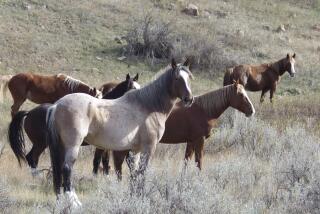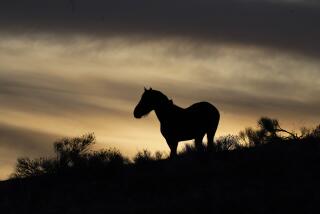Wild horses aren’t free
It’s not news that America is a cowboy nation, but it may surprise many that we are destroying the horse we rode in on.
Since the early 1970s, mustangs -- wild horses -- have been protected under the Wild Free-Roaming Horses and Burro Act, spearheaded by Velma Johnston, a.k.a. Wild Horse Annie. In 1950, she saw blood spilling out of a truck on a Nevada highway, followed it, and then witnessed injured and dying mustangs being offloaded at a slaughterhouse. She led a battle to stop the cruel roundups, resulting in the passage of federal protection signed into law by President Nixon in 1971.
Under that law, horses are to be “considered in areas where presently found as an integral part of the system of public lands.” Their management falls to agencies inside the Department of the Interior, primarily the Bureau of Land Management, which culls the herds based on the land’s grazing capacity and what’s required to sustain the wild horse population. But the government also balances the needs of horses against other uses of the range -- and that means corporate cattle ranching. Today, instead of being protected, mustangs are in danger of being “managed” out of existence.
At the beginning of the 20th century, there were about 2 million mustangs in the wilderness; according to the government, there are about 23,000 on public lands in the Western states now, and more than half are in Nevada. Wild horse advocates, however, say the number is much lower. Because the animals have been “zeroed out” from at least 100 of their 300 official herd areas (contrary to the 1971 law’s provisions), they may be on the brink of no return.
Many cattle ranchers have long regarded wild horses as “pests” that steal food from their herds. The livestock lobby has tried to dismantle the wild horse and burro law through four U.S. administrations, and it has the political clout to push policy toward a mustang-free America.
In 1990, the Government Accounting Office looked at the situation: “Wild horses are vastly outnumbered on range lands by livestock. ... Wild horse removals have taken place in some areas not being damaged by widespread overgrazing.” Since then, cattle have continued to flourish on the range. Today, at least 3 million cattle graze on the same public lands where mustangs make their living.
One of the stockmen’s victories has been a rollback in the 1971 law. When mustangs and burros are culled from wild herds, they are warehoused by the government and offered for adoption. In 2005, the rules were changed. Now, if horses aren’t adopted on the third try, they “strike out,” becoming eligible for sale to the lowest bidder along with mustangs more than 10 years old (not old for a horse). This means an eventual ticket to the slaughterhouse.
This policy is aggravated by federal grazing studies that, because of a lack of funding, are often out of date in terms of horse populations and favor the livestock lobby’s version of “appropriate management levels.”
“AMLs are frequently inaccurate and not determined in accordance with the law,” says Patricia Fazio, an environmental historian who has monitored the mustang situation for more than two decades. “Where oh where has scientific management and substantive public input for federal lands gone?”
Wild horse populations also endure other stresses, such as unscheduled “gathers” during drought. (No other animal is rounded up under such conditions, and the horses aren’t returned to the range after being given a drink.) And none of this is helped by media that parrot the view that the mustang is an invasive species.
In fact, mustangs are native to this continent, linked by DNA to horses of the Pleistocene. They evolved in the North American West, crossed the Bering land bridge to Asia and Europe, and then died out on their native turf in the Ice Age. They returned with the conquistadors in the 16th century, and for the next 300 years, roaming free or put to work as trailblazers, Indian ponies or cowboy transportation, they were an essential part of the West.
By the end of the 19th century, mustangs, along with the rest of the Wild West, were heading toward anachronism. A hydra-headed horseflesh industry arose. Mustangers ripped into the herds, trapping horses and selling them for chicken feed, or dinner in France, or service in foreign wars. So many were taken from 1920 to 1935 that the era is known in some circles as “the great removal.”
Today, the roundups continue under cover of what is left of the law. Mustang posses are tax subsidized (although lone operators with guns hunt horses illegally as well). Federal contractors hunt “humanely” by helicopter. During the last eight years, about 75,000 wild horses have been taken from the land. There are now more wild horses in government custody than on the range.
Eighteen years after the first GAO investigation of the wild horse and burro program, a new one is underway. Perhaps it will uncover the absurdity of protecting wild horses and burros by reducing herds in unwarranted numbers, allowing them to languish in government corrals and making it ever easier to send them to slaughter.
In the meantime, our heritage is being stripped from the land, with roundups scheduled through the year. Now is the time for an immediate moratorium on wild horse removals, at least until population studies are brought up to date.
“We need the tonic of wildness,” Nixon said, quoting Thoreau when he signed Wild Horse Annie’s legislation. “Wild horses merit protection as a matter of ecological right, as anyone knows who has stood awed at the indomitable spirit and sheer energy of a mustang running free.”
More to Read
Sign up for Essential California
The most important California stories and recommendations in your inbox every morning.
You may occasionally receive promotional content from the Los Angeles Times.










